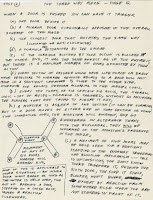As another anniversary of the birth of Dungeons & Dragons passes, let's look back 48 years to the heady days of 1974, when the idea of dungeon adventuring had only just started to capture the imagination of gamers at large. Alistair MacIntyre had long run "Operation Contact" for the International Federation of Wargaming, so he knew everyone and viewed the release of D&D with some interest -- though he confessed, "I don't have the time or knowledge of fantasy to participate in your underground adventures." He was however "fascinated by the dungeon mazes," and came up with a number of devious dungeon layouts that he photocopied and shared directly with Gary Gygax and others that summer of 1974. Above you can see a dungeon entrance from the wilderness that MacIntyre proposed -- and at the bottom of the cut below, there's a little trick from Gary himself as well.
MacIntyre envisioned a number of very elaborate mechanisms for duping unwary adventurers, including this two-page description of the diabolical "three-way place," a series of connecting doors that mask intersections, making it nearly impossible for adventurers to retrace their steps -- or to avoid being steered towards a waiting monster:
Anticipating the trend of "fun-house" dungeons, MacIntyre offered a grab bag of mirrors, rotating disks, and pivoting doors that would surely prove baffling to anyone trying to navigate an underworld:







Several of these features were echoed (and/or independently devised) later by Roger Musson in his "Dungeon Architect" articles in White Dwarf 25-27 (June/July 1981 to Oct/Nov 1981).
ReplyDeleteAllan.
I find these early dungeon design notes quite fascinating - thanks for sharing them!
ReplyDeleteFor old school DND there is good reason only like one in six players have no problem being a mapper. For most people trying to figure out why in your make-believe world you’re going around in circles, encountering dead ends, and going down deeper when they’re not aware they’re doing so (usually not a problem because like 80% of parties will have a dwarf) it’s not exactly the call to adventure. And. and one thing that really makes eyes glaze over at the game table is the realization that you’ve just spent an hour trying to map 30 feet of dungeon.
ReplyDelete